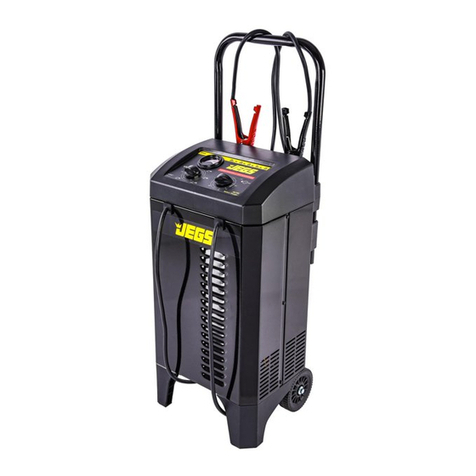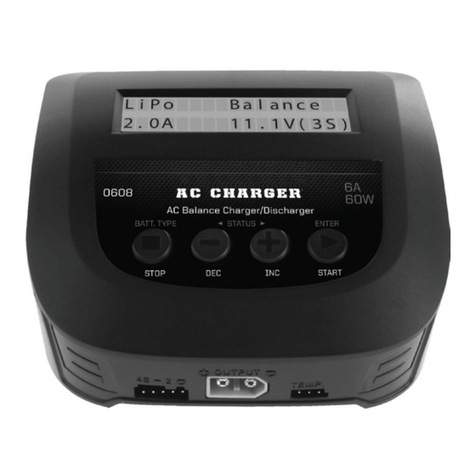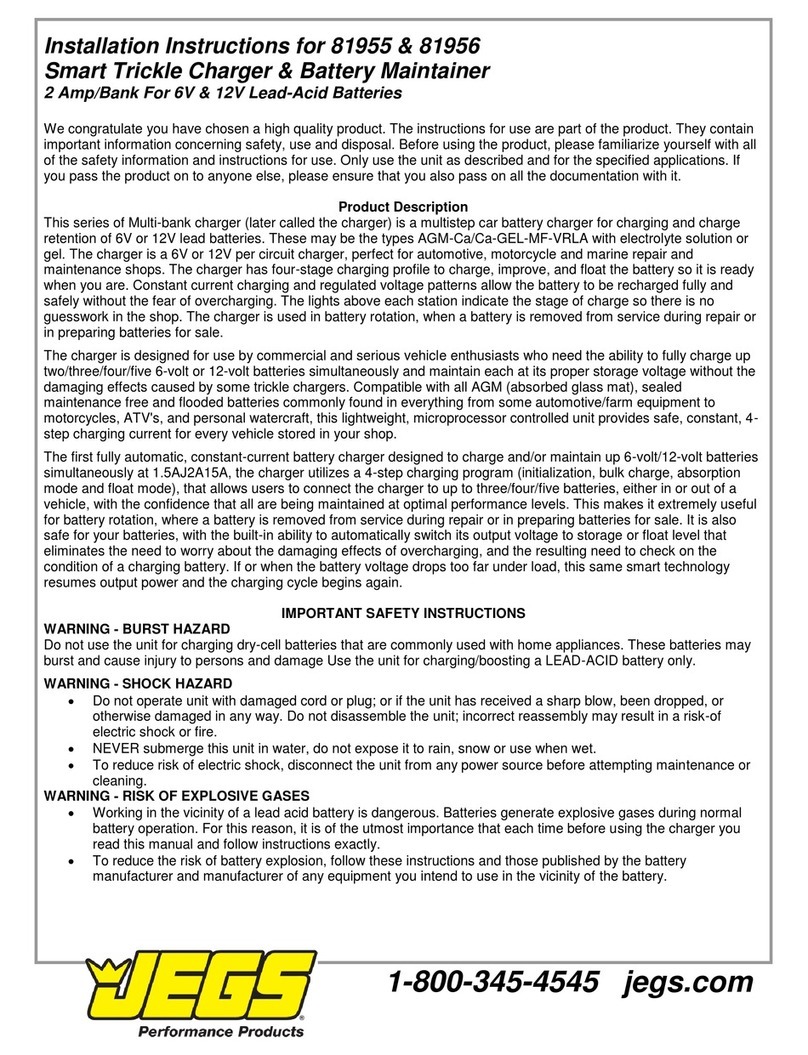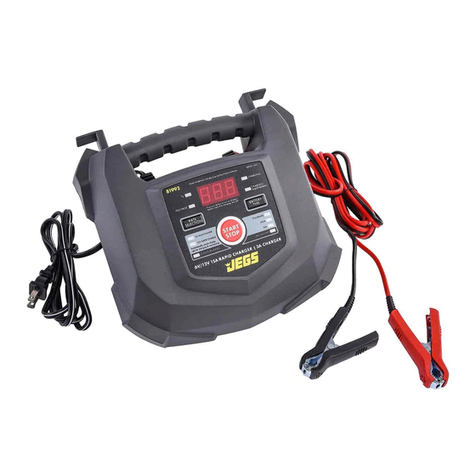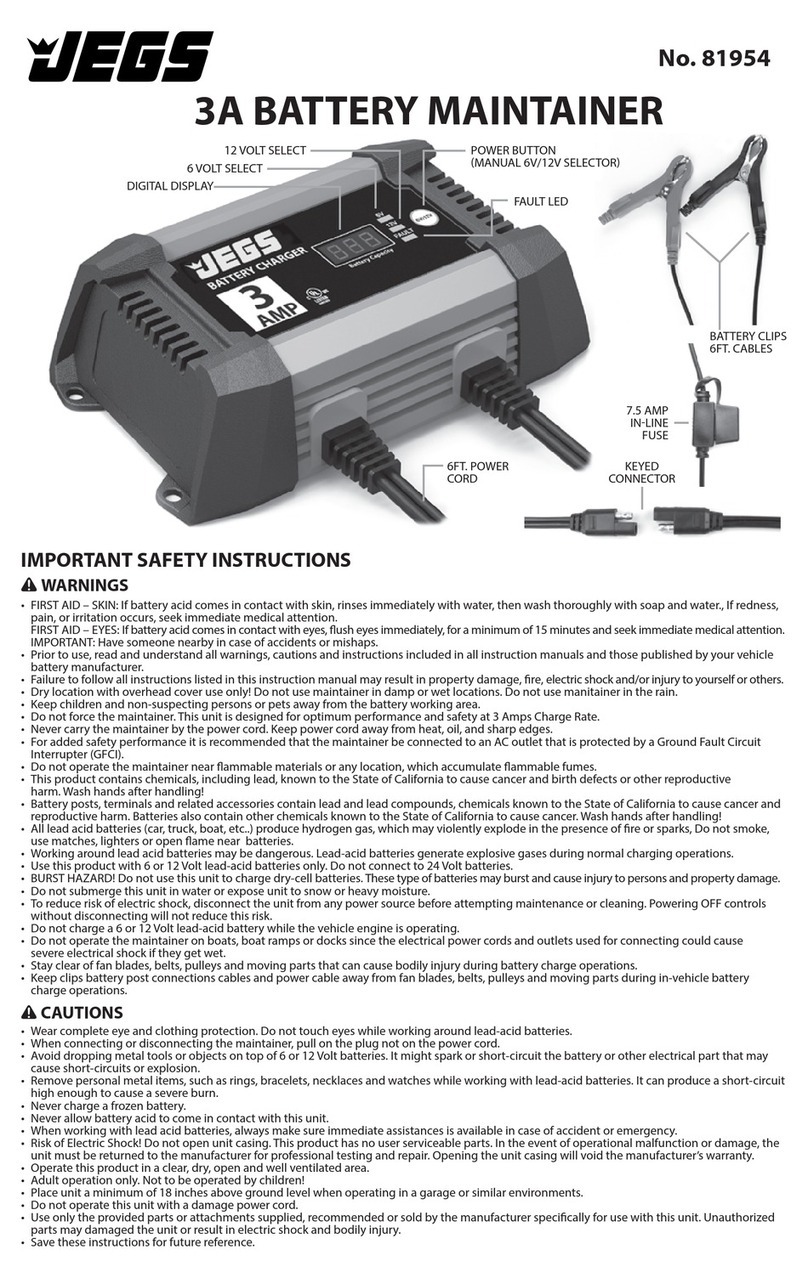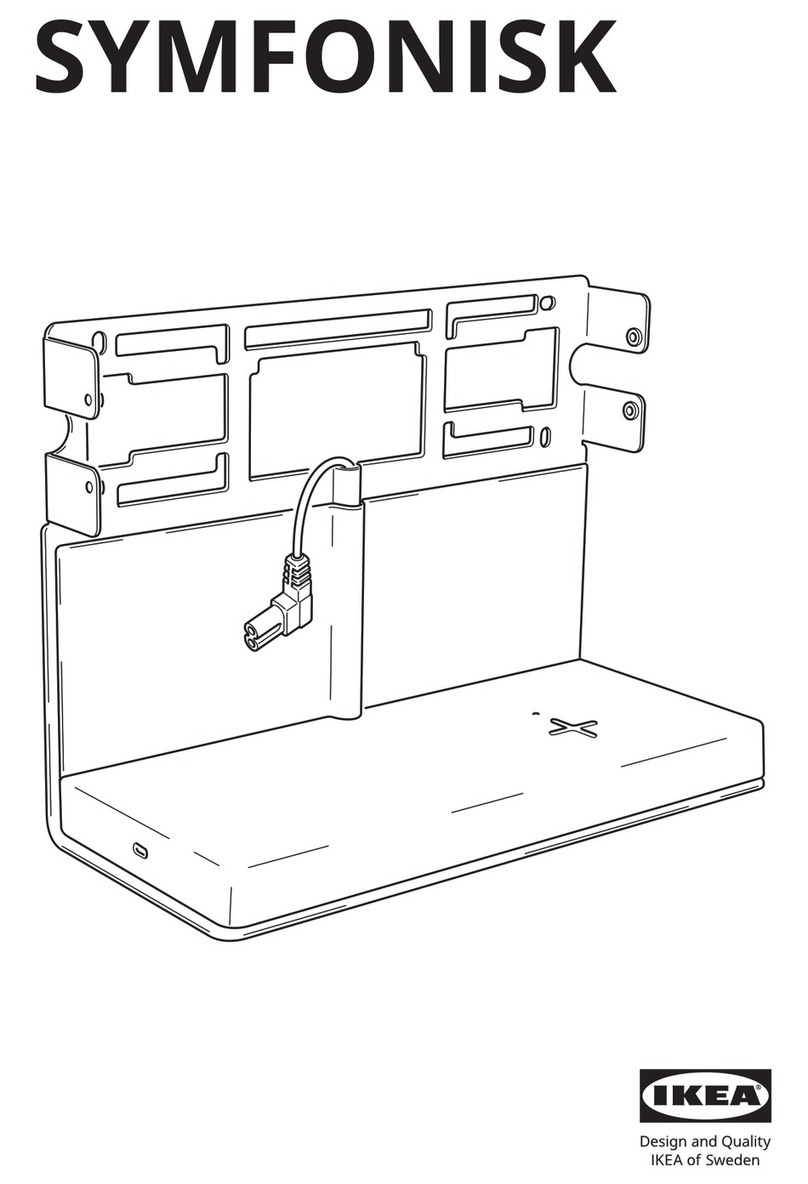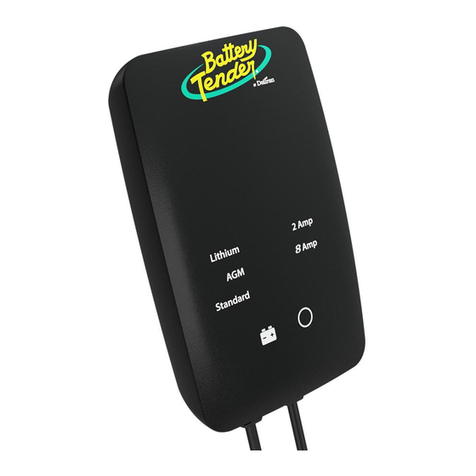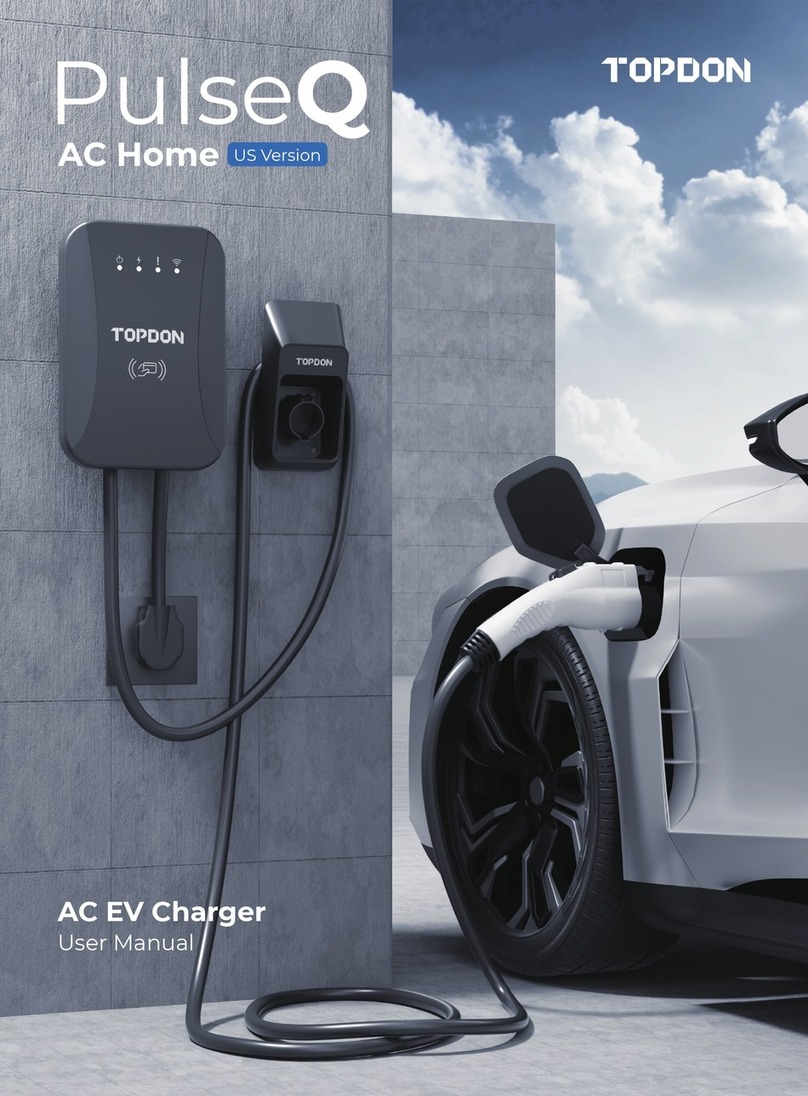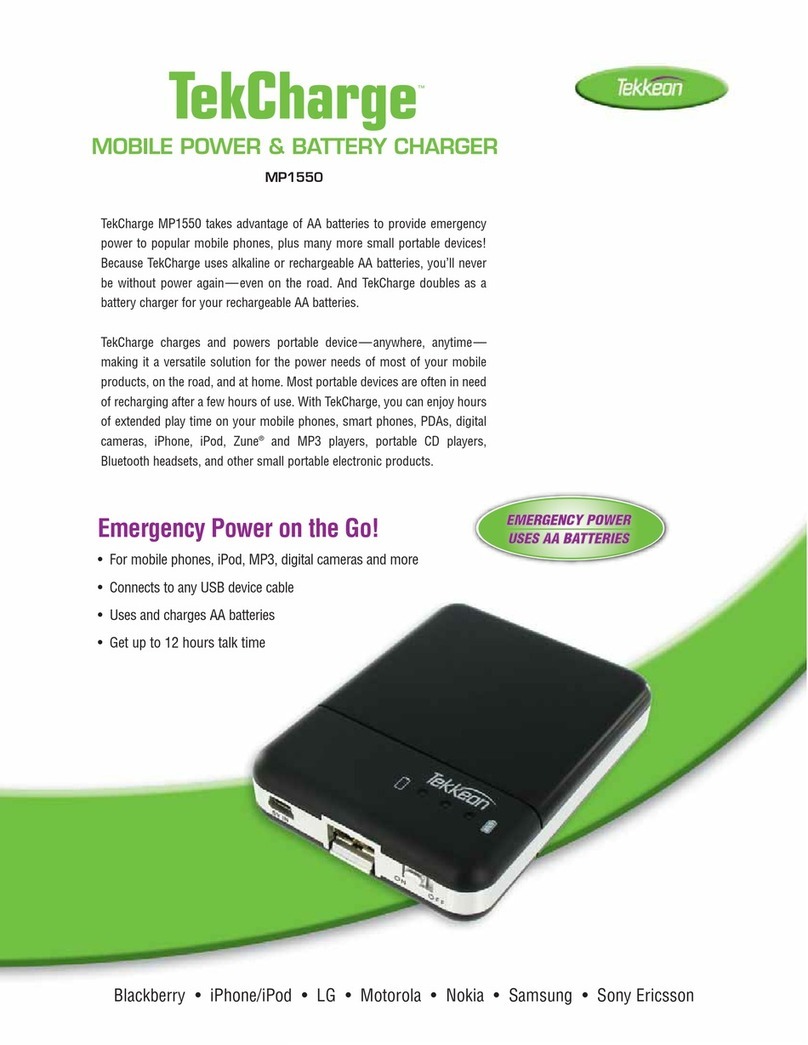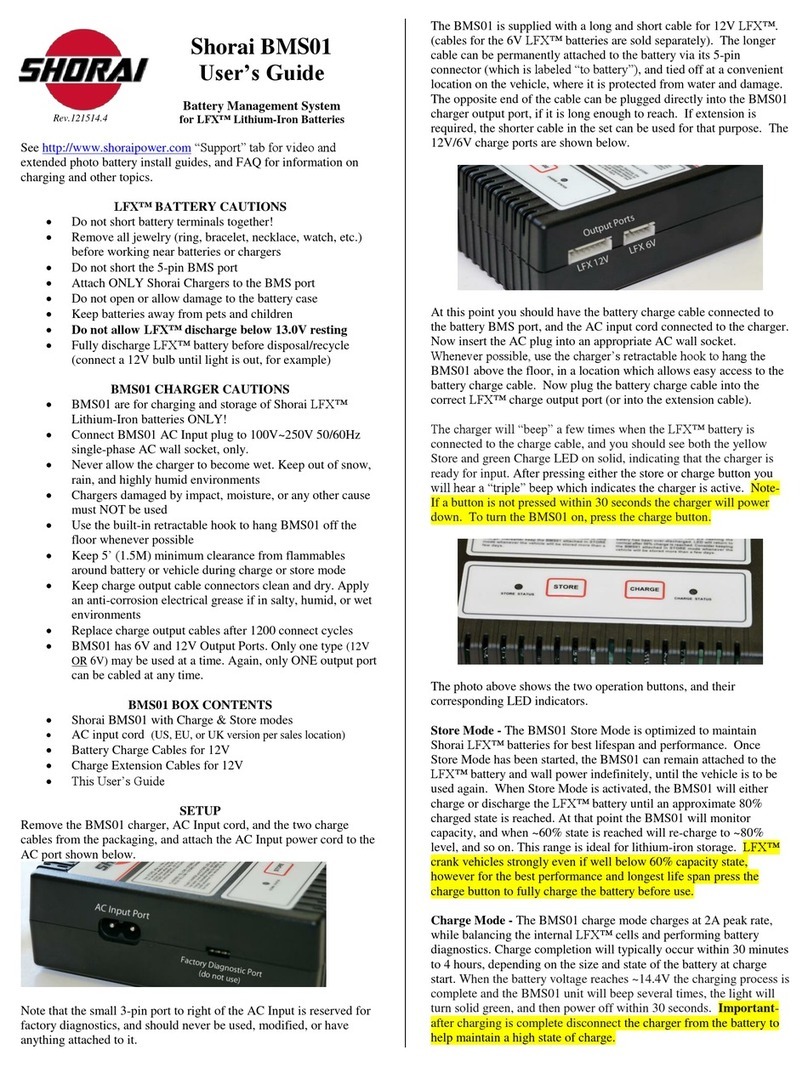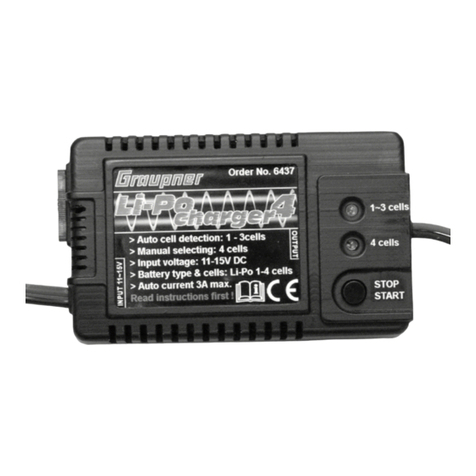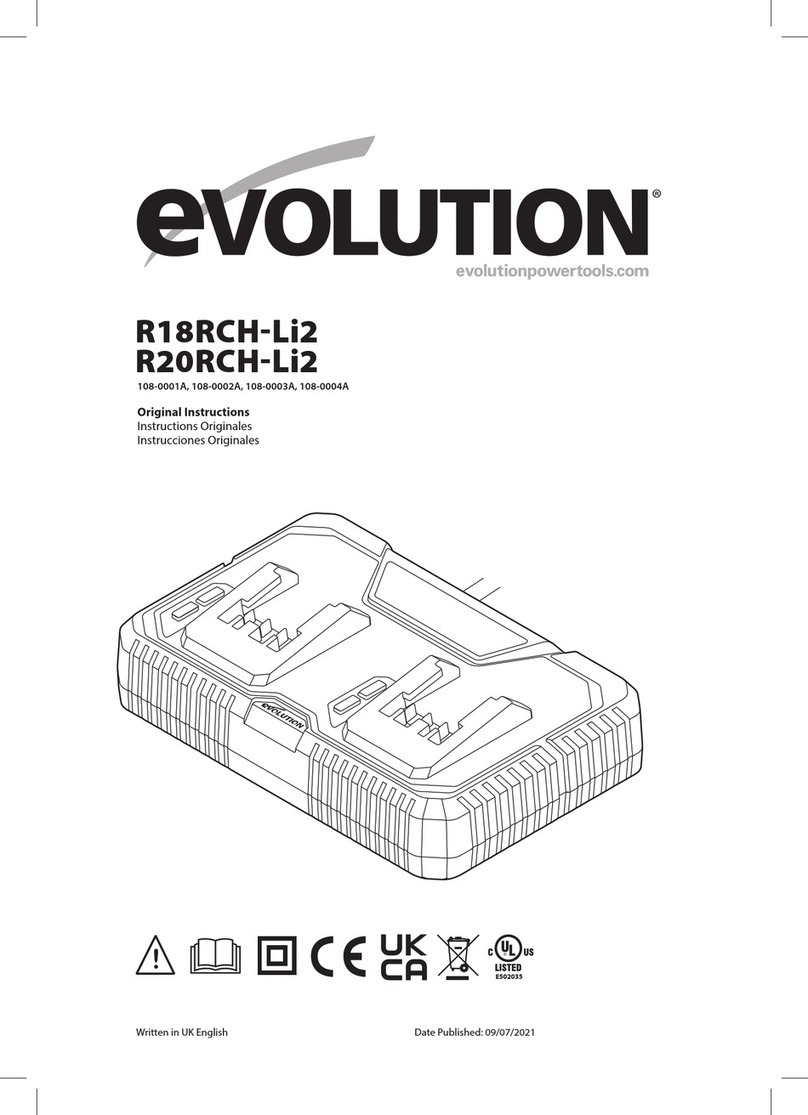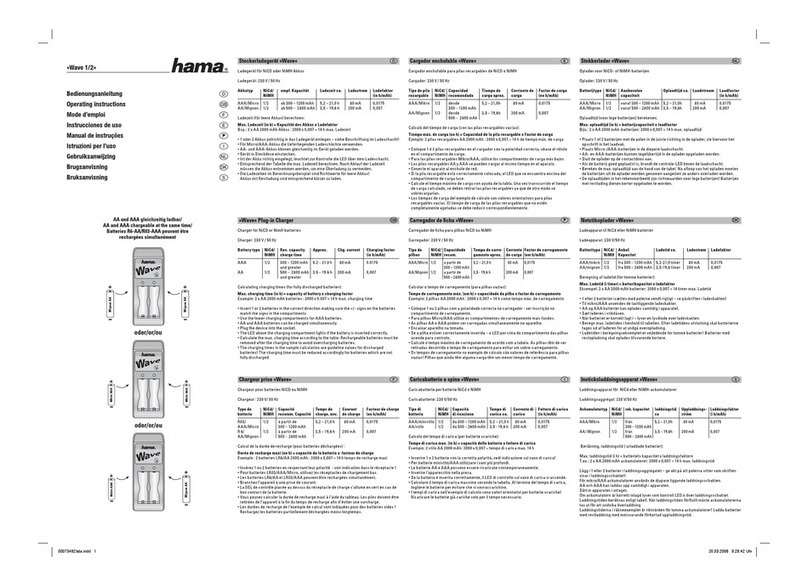Jegs 81961 User manual

Installation Instructions for 81961
Battery Maintainer 7 Float Charger
75 Amp, 12 V
Save this Manual Keep this manual for the safety warnings and precautions, assembly, operating,
inspection, maintenance and cleaning procedures. Write the product’s serial number in the back of
this manual near the assembly diagram (or month and year of purchase if product has no number).
Keep this manual and the receipt in a safe and dry place for future reference.
Read this material before using this product. Failure to do so may result in serious injury.
1-800-345-4545 jegs.com

1. SAVE THESE INSTRUCTIONS
–This manual contains important safety and operating instructions for this battery charger.
2. Do not expose charger to rain or snow.
3. Use of an attachment not recommended or sold by the battery charger manufacturer may result in a risk of fire,
electric shock, or injury to persons.
4. To reduce risk of damage to electric plug and cord, pull by plug rather than cord when disconnecting charger.
5. Do not use an extension cord with this item.
6. Do not operate charger with damaged cord or plug –replace the cord or plug immediately.
7. Do not operate charger if it has received a sharp blow, been dropped, or otherwise damaged in any way; take it to a
qualified serviceman.
8. Do not disassemble charger; take it to a qualified serviceman when service or repair is required. Incorrect
reassembly may result in a risk of electric shock or fire.
9. To reduce risk of electric shock, unplug charger from outlet before attempting any maintenance or cleaning.
10. WARNING –RISK OF EXPLOSIVE GASES.
a. WORKING IN VICINITY OF A LEAD-ACID BATTERY IS DANGEROUS. BATTERIES GENERATE
EXPLOSIVE GASES DURING NORMAL BATTERY OPERATION. FOR THIS REASON, IT IS OF UTMOST
IMPORTANCE THAT YOU FOLLOW THE INSTRUCTIONS EACH TIME YOU USE THE CHARGER.
b. To reduce risk of battery explosion, follow these instructions and those published by battery manufacturer
and manufacturer of any equipment you intend to use in vicinity of battery. Review cautionary marking on these
products and on engine.
11. PERSONAL PRECAUTIONS
a. Consider having someone close enough by to come to your aid when you work near a lead-acid battery.
b. Have plenty of fresh water and soap nearby in case battery acid contacts skin, clothing, or eyes.
c. Wear complete eye protection and clothing protection. Avoid touching eyes while working near battery.
d. If battery acid contacts skin or clothing, wash immediately with soap and water. If acid enters eye,
immediately flood eye with running cold water for at least 10 minutes and get medical attention immediately.
e. NEVER smoke or allow a spark or flame in vicinity of battery or engine.
f. Be extra cautious to reduce risk of dropping a metal tool onto battery. It might spark or short-circuit battery or
other electrical part that may cause explosion.
g. Remove personal metal items such as rings, bracelets, necklaces, and watches when working with a lead-
acid battery. A lead-acid battery can produce a short-circuit current high enough to weld a ring or the like to
metal, causing a severe burn.
h. Use charger for charging LEAD-ACID or Absorbed Glass Mat (AGM) batteries only. It is not intended to
supply power to a low voltage electrical system other than in a starter-motor application. Do not use battery
charger for charging dry-cell batteries that are commonly used with home appliances. These batteries may
burst and cause injury to persons and damage to property.
i. NEVER charge a frozen battery.
1-800-345-4545 jegs.com

12.PREPARING TO CHARGE
a. If necessary to remove battery from vehicle to charge, always remove grounded terminal from battery first.
Make sure all accessories in the vehicle are off, so as not to cause an arc.
b. Be sure area around battery is well ventilated while battery is being charged.
c. Clean battery terminals. Be careful to keep corrosion from coming in contact with eyes.
d. Add distilled water in each cell until battery acid reaches level specified by battery manufacturer. Do not
overfill. For a battery without removable cell caps, such as valve regulated lead acid batteries, carefully follow
manufacturer’s recharging instructions.
e. Study all battery manufacturer’s specific precautions while charging and recommended rates of charge.
f. Determine voltage of battery by referring to vehicle owner’s manual and make sure it matches output rating of
battery charger.
g. Do not place charger or electrical connections on ground or floor.
13. DC CONNECTION PRECAUTIONS
a. Connect and disconnect DC output clips only after disconnecting Quick-Connector. Never allow clips to
touch each other.
b. Attach terminals to battery as indicated below.
14. FOLLOW THESE STEPS. A SPARK NEAR BATTERY MAY CAUSE BATTERY EXPLOSION. TO REDUCE
RISK OF A SPARK NEAR BATTERY:
a. Position cables to reduce risk of damage by hood, door, or moving engine part.
b. Stay clear of fan blades, belts, pulleys, and other parts that can cause injury to persons.
c. Check polarity of battery connectors. POSITIVE (POS, P, +) battery connector usually has larger diameter
than NEGATIVE (NEG, N, –) post.
d. Disconnect Quick-Connector.
e. To permanently attach the Ring Terminal Connector to the battery, bolt POSITIVE (RED) ring terminal to
POSITIVE (POS, P, +) post of battery. Bolt NEGATIVE (BLACK) Ring Terminal Connector to NEGATIVE
(NEG, N, –) post of battery.
f. To temporarily attach the Clip Connector to the battery, connect POSITIVE (RED) Clip Connector to
POSITIVE (POS, P, +) post of battery. Connect NEGATIVE (BLACK) Clip Connector to NEGATIVE
(NEG, N, –) post of battery. Do not connect Clip Connector to carburetor, fuel lines, or sheet-metal body parts.
Do not leave Clip Connectors attached indefinitely.
g. When disconnecting charger, disconnect and cap Quick-Connector, and then remove Clip Connector from
battery terminal.
h. See operating instructions for length of charge information.
15. Do not turn on equipment that battery is connected to while charging.
16. Wear ANSI-approved splash-resistant safety goggles and heavy-duty rubber work gloves whenever connecting,
disconnecting, or working near battery. Battery acid can cause permanent blindness.
1-800-345-4545 jegs.com

17. Maintain labels and nameplates on the charger. These carry important safety information. If unreadable or missing,
contact JEGS for a replacement.
18. This product is not a toy. Keep it out of reach of children.
19. Disconnect and cap the Quick-Connector before connecting its cables to a battery, or performing any inspection,
maintenance, or cleaning procedures.
20. Use this Charger/Maintainer with flooded lead-acid batteries or Absorbed Glass Mat (AGM) batteries only. When
charging a maintenance-free battery, always monitor the progress of the charge by viewing the ammeter. Do not over-
charge a maintenance-free battery.
21. Do not use this maintainer with gel lead-acid type batteries.
22. Do not attempt to charge non-rechargeable, damaged, or defective batteries.
23. Do not charge more than one battery at one time.
24. Remove charger AC Adapter from electrical outlet, unplug and cap Quick-Connector, and disconnect the battery
clamps (if used) when finished.
25. Have your charger serviced by a qualified repair person using only identical replacement parts. This will ensure that
the safety of the charger is maintained.
26. Do not use charger while you are tired or under the influence of drugs, alcohol or medication. A moment of
inattention while operating charger may result in serious personal injury.
27. Do not leave charger or battery unchecked for extended periods of time to reduce risk.
28. Before moving charger, disconnect power supply and battery, then allow charger to cool.
29. This product is not a toy. Do not allow children to play with or near this item.
30. Use as intended only.
31. People with pacemakers should consult their physician(s) before use. Electromagnetic fields in close proximity to
heart pacemaker could cause pacemaker interference or pacemaker failure.
In addition, people with pacemakers should:
• Avoid operating alone.
• Properly maintain and inspect to avoid electrical shock.
• Properly ground power cord. Ground Fault Circuit Interrupter (GFCI) should also be implemented –it prevents
sustained electrical shock.
32. WARNING: Handling the cord on this product will expose you to lead, a chemical known to the State of California to
cause cancer, and birth defects or other reproductive harm. Wash hands after handling.
(California Health & Safety Code § 25249.5, et seq.)
33. The warnings, precautions, and instructions discussed in this instruction manual cannot cover all possible
conditions and situations that may occur. It must be understood by the operator that common sense and caution are
factors which cannot be built into this product, but must be supplied by the operator.
34. Inspect before every use; do not use if parts are loose or damaged.
35. Use with 12 volt batteries only.
SAVE THESE INSTRUCTIONS.
1-800-345-4545 jegs.com

Specifications
Input
120VAC, 60Hz, 0.25A
Rated Output
0.75 A /12 VDC
Maximum Output
13.2 VDC
Battery Capacity
5 –125 Ah
Cable Length
12 ft.
Fuse
7.5A Blade-type
Operation Instructions
Read the ENTIRE IMPORTANT SAFETY INFORMATION section at the beginning of this document including
all text under subheadings therein before set up or use of this product.
Note: This Float Charger is intended only to keep a fully charged battery from losing its charge. It will not work to
charge a battery that is discharged or damaged.
Notice
TO PREVENT BATTERY DAMAGE: Do not use on gel lead-acid type batteries.
Note: Check battery voltage with a multimeter before use.
The Battery MUST be fully charged to at least 12 Volts.
The Float Charger prevents self-discharge of the battery, while maintaining the life of rechargeable 12 volt lead-acid
batteries. It maintains a battery charge for batteries rated from 5 –125 Ah (amp-hours), by providing a 13.2 VDC
maximum output. Other types of chargers provide a strong, rapid charge but tend to boil out liquids and decay
electrodes.
Connection
A SPARK NEAR BATTERY MAY CAUSE BATTERY EXPLOSION.
TO REDUCE RISK OF A SPARK NEAR BATTERY follow these instructions exactly.
TO PREVENT SERIOUS INJURY:
Wear ANSI-approved splash-resistant safety goggles and heavy-duty rubber work gloves whenever
connecting, disconnecting, or working near battery. Battery acid can cause permanent blindness.
1. Place Float Charger within 3 feet of battery. Disconnect the Quick-Connectors from each other.
2. Select the Connector appropriate to the battery.
3. To permanently attach the Ring Terminal Connector to the battery:
a. Bolt POSITIVE (RED) Ring Terminal Connector to POSITIVE (POS, P, +) post of battery.
b. Bolt NEGATIVE (BLACK) Ring Terminal Connector to NEGATIVE (NEG, N, –) post of battery.
4. To temporarily attach the Clip Connector to the battery,
a.Connect POSITIVE (RED) Clip Connector to POSITIVE (POS, P, +) post of battery.
b.Connect NEGATIVE (BLACK) Clip Connector to NEGATIVE (NEG, N, –) post of battery
WARNING! TO PREVENT SHORT CIRCUIT AND FIRE: Do not leave Clips attached indefinitely.
WARNING! Do not connect Connector to carburetor, fuel lines, or sheet-metal body parts.
5.The LED (Light Emitting Diode) will not light while cables are disconnected.
6. Join the Connector’s Quick-Connector plug with that of the AC Adapter.
7.If cables are connected improperly, disconnect the Quick-Connector plugs, correct the battery connections,
and re-connect the Quick-Connector plugs.
1-800-345-4545 jegs.com

1-800-345-4545 jegs.com
LED Functions
1.Flashing Red: The Battery is connected improperly or not functioning at all.
2.Solid Red: The Battery is charging.
3.Flashing Green: The Battery is nearly completely charged.
4.Solid Green: The Battery is completely charged, and the Maintainer is monitoring the charged Battery.
After Use
1. Separate the Quick-Connector plugs and cap them with the attached caps.
2. Unplug the AC Adapter.
3. Depending on the Connector in use, either:
• Stow Ring Terminal Connector safely next to battery. Keep clear of belts, blades, and any other
moving engine parts.
• Remove Clip Connector from battery.
4. Wipe the Charger with a clean, dry cloth and store indoors out of reach of children.
Maintenance Instructions
Procedures not specifically explained in this manual must be performed only by a qualified technician.
WARNING TO PREVENT SERIOUS INJURY: Unplug the charger, disconnect any battery, and allow charger to
cool completely before performing any inspection, maintenance, or cleaning procedures.
TO PREVENT SERIOUS INJURY FROM TOOL FAILURE: Do not use damaged equipment. If abnormal noise or
vibration occurs, have the problem corrected before further use.
1. BEFORE EACH USE, inspect the general condition of the charger. Check for:
• loose hardware,
•cracked or broken parts,
•damaged electrical wiring or cable insulation, and
•any other condition that may affect its safe operation
2. If the fuse needs replacing:
a. Disconnect the Connector from the AC Adapter and/or the battery.
b. Uncap the Fuse Housing.
c. Remove the spent fuse and replace with a new 7.5 Blade-type fuse.
d. Recap the Fuse Housing.
Note: Aside from the fuse, this device does not contain any user replaceable parts. If it needs service, take it to a
qualified technician.
3. AFTER USE, wipe external surfaces of the tool with clean cloth.
4. WARNING! If the supply cord of this charger is damaged, it must be replaced only by a qualified service
technician. DO NOT OPEN CHARGER HOUSING, NO USER-SERVICEABLE PARTS INSIDE.
Parts List
Part
Description
Qty
1
AC Adapter
1
2
Ring Terminal Connector
1
3
Clip Connector
1
Table of contents
Other Jegs Batteries Charger manuals
Popular Batteries Charger manuals by other brands
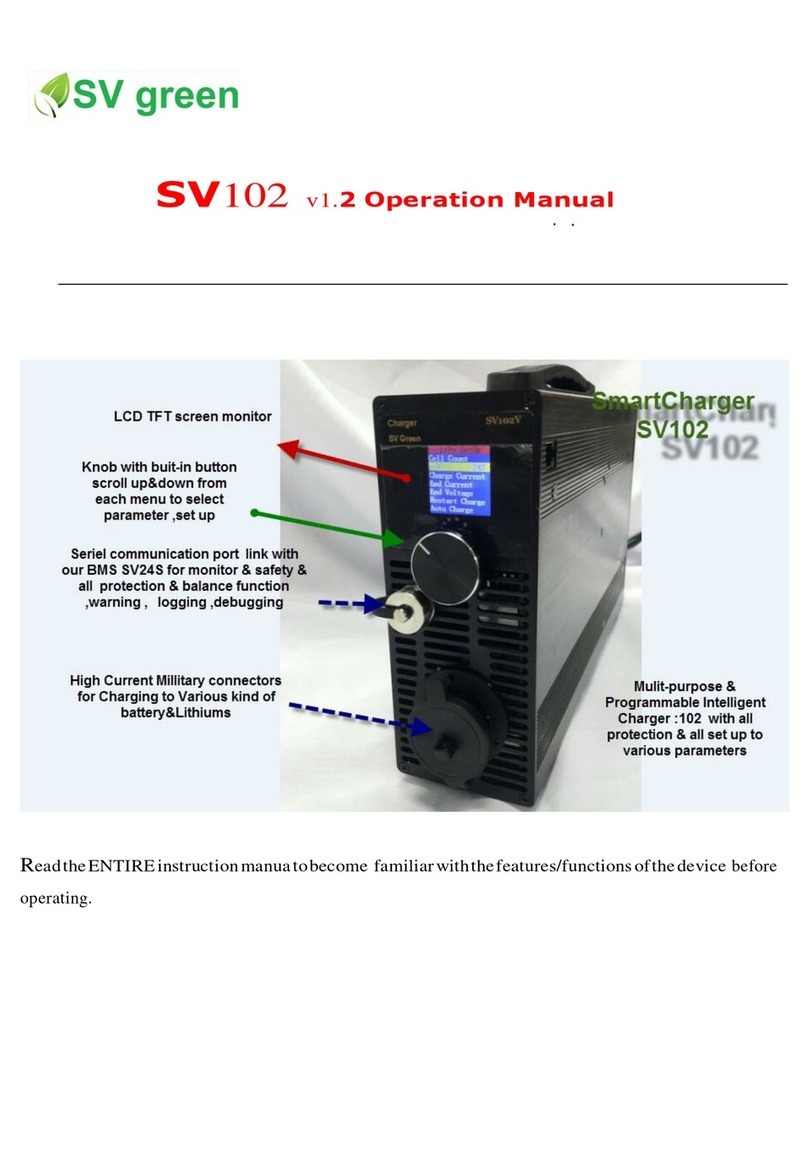
SV green
SV green Smart Charger SV102 Operation manual
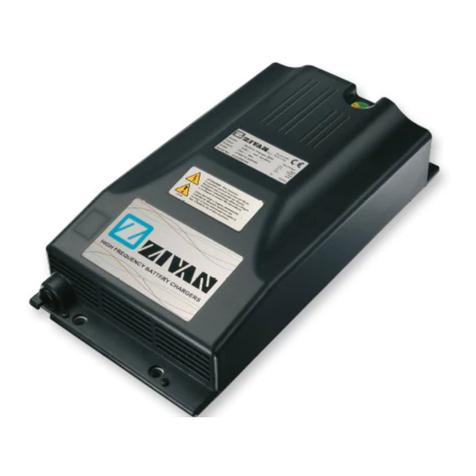
Zivan
Zivan NG3 CANBUS Installation and user manual
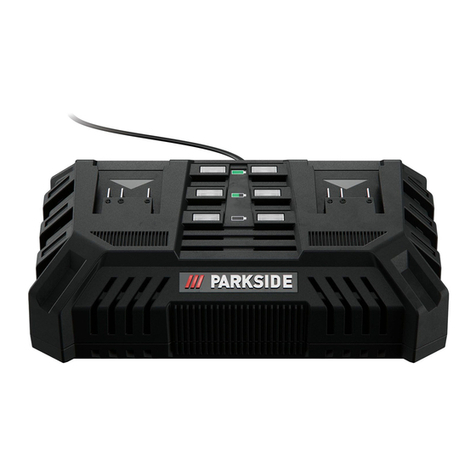
Parkside
Parkside PDSLG 20 A1 Translation of the original instructions

Victron energy
Victron energy Blue Power 12/7 technical information
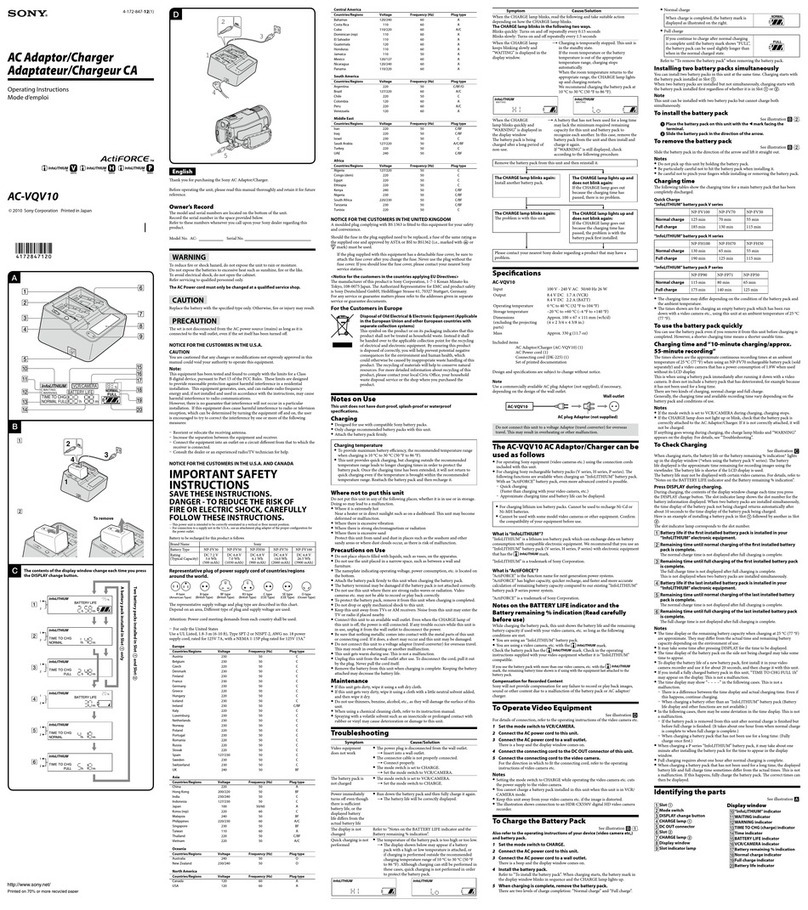
Sony
Sony AC-VQV10 operating instructions

Schumacher
Schumacher PS-1025 instruction manual
